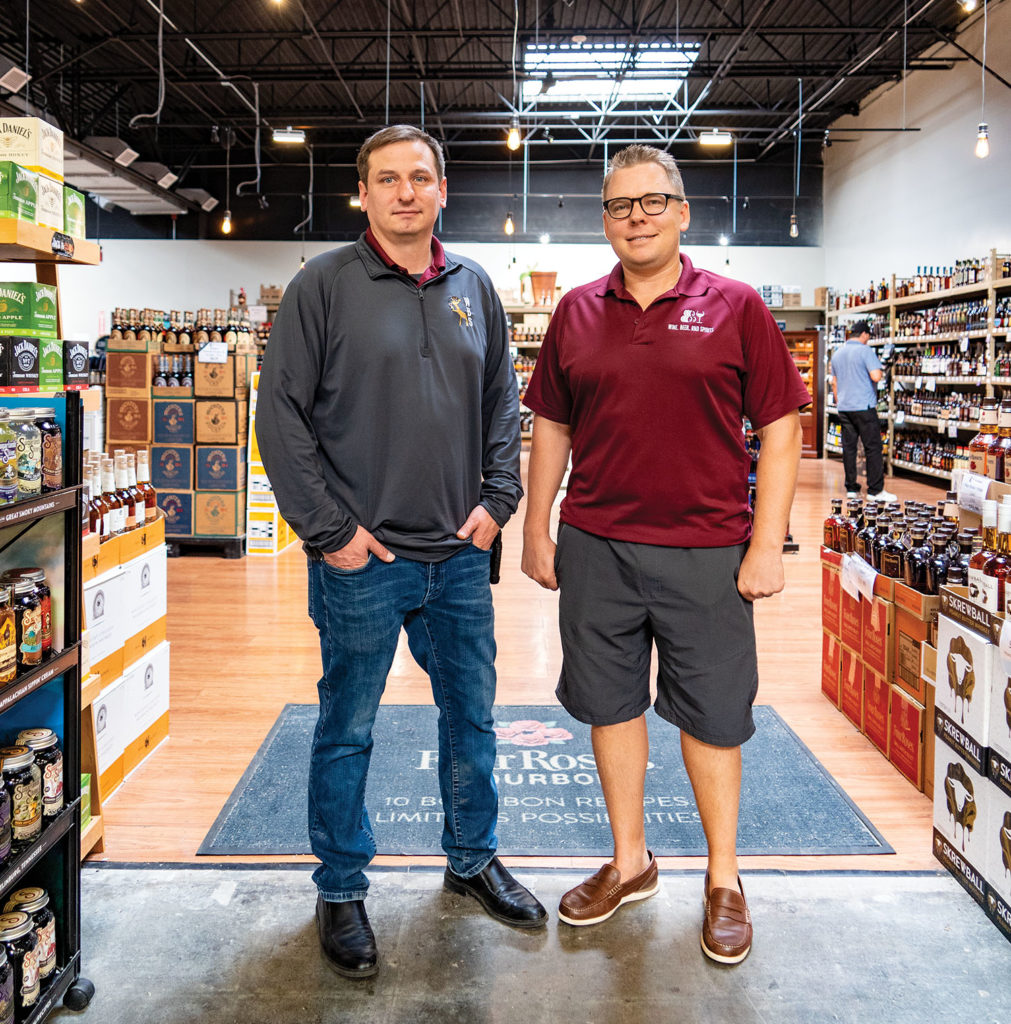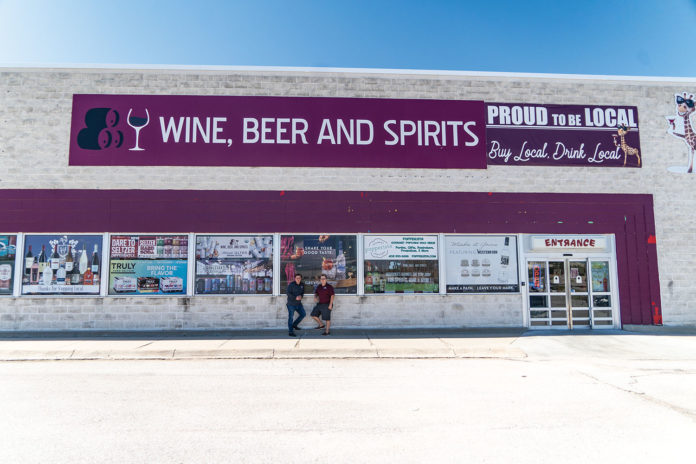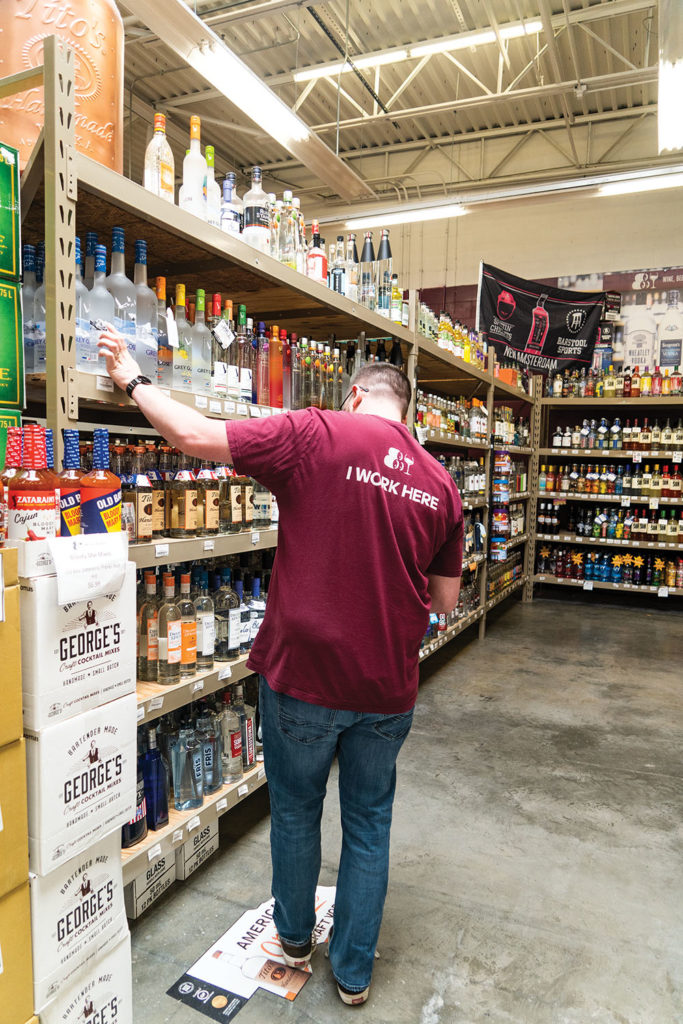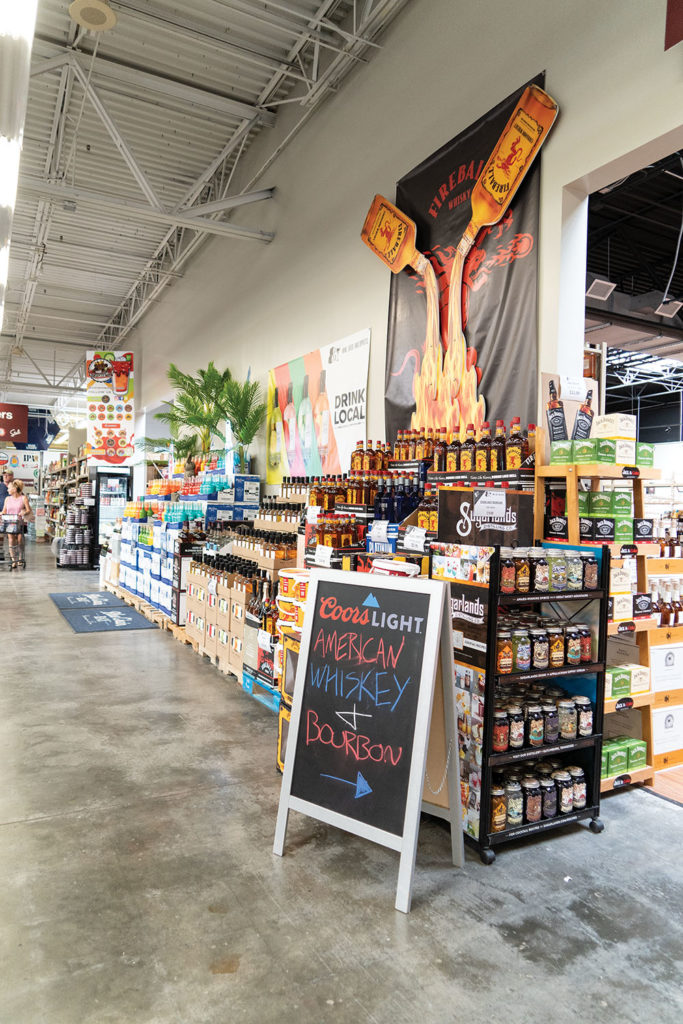“Every entrepreneur needs a little bit of luck starting out,” says Aaron Konen, CFO and co-founder of the fast-growing Nebraska-based chain, Wine, Beer, and Spirits. “For us, we timed it right, but certainly not on purpose.”
Only luck could have provided timing so perfect. In late 2019, Aaron and cofounders Beau Starkel and Jacob Heiliger — now CEO and COO, respectively — were in the process of opening their first store when Covid-19 hit. Rapid growth followed for that Omaha Wine, Beer, and Spirits, approximately 30,000-square-feet and 7,500 SKUs. A second, equally sized location opened in Lincoln in December of 2020, followed by a third, around 50,000 square feet, in the city of Grand Island, NE, in August 2021.
“All three stores are performing well, with a $30 million run rate,” Konen says. “It’s no small feat, getting all that done during Covid.”
Burnishing this accomplishment, the founding team did not originate from a retail background.
The Right Real Estate
Wine, Beer, and Spirits is a college dream come true.
Konen and Starkel became friends while attending graduate school together. Later, they opened several successful taprooms together. While still in college, they frequented Brix, a large alcohol retailer in Omaha. The pair noted the store’s good reputation and consistent foot traffic, but also its needlessly expensive interiors and other questionable management.
If Konen and Starkel ever got the necessary funds, they vowed to open a large-scale alcohol retailer, but more in the vein of Costco. “We wanted to focus on the customer, having good breadth of products at fair prices, and just having fun,” Konen says.
Years later, having succeeded with taprooms, the entrepreneurs returned their attention to off-premise. Part of their plan involved purchasing their own real estate outright — and cheaply. A bankruptcy trustee led them to the area’s former Toys “R” Us, which had closed.

“We wanted to own our buildings to control our cost structure,” Konen says. “We bid on that Toys “R” Us at auction like on eBay. We won the auction, but didn’t have the money. So we figured it out.”
This theme of rapid adaptation has helped propel the meteoric rise of Wine, Beer, and Spirits. Heiliger, who was running the taprooms, led the new retail project. He worked day and night, with a mattress and a pillow in a backroom, to make it work.
“It was trial by fire,” Heiliger remembers. “We were making decisions on the fly. We were seeing what our competitors were doing and how we could try to be different and sticking to that.”
His work continued when the bankruptcy trustee identified a second vacant Toys “R” Us, shortly thereafter, in Lincoln.
“That was a 45-day period between us getting that license and opening the store,” Konen recalls. “We were able to save 80 to 90 percent of our renovation budget, because we had gotten a lot smarter and quicker after learning from our Omaha store.”
Operating out of former Toys “R” Us locations has proved effective marketing.
“There’s a sense of nostalgia at these places,” Heiliger says. “A lot of people remember those old stores fondly. The Toys “R” Us may be gone inside, but we still have their numbers up at the check-out stands. The bathrooms still say ‘boys and girls’.” And at Omaha, one wall still sports a large decal of Pac-Man.
“Some of the locals now call us Booze “R” Us,” says Marketing Director Daniel Galvis. “We have a hundred nicknames already. Booze Warehouse is another. I was heading to our Lincoln store one day and was pulled over. The cop noticed the booze in my passenger seat and asked where I was going. When I said where, he replied, ‘Oh, you’re going to church’. I was confused. So he explained. Turns out there was a group of cops who go there every Sunday. They say it’s their ‘sacred place’.”
Hospitality at Retail
Customers like coming to Wine, Beer, and Spirits. It’s by design, of course. With the leadership team’s roots in on-premise, they have cultivated a hospitality focus. This includes in-store bars built upfront, and staff who know how to treat customers right.
“We’re willing to put in the labor hours and money to have enough knowledgeable staff at every store in order to connect with our customers,” Heiliger says. “Building loyalty with customers is brand loyalty.”
Among the three stores, Wine, Beer, and Spirits employees 60 to 65 people. When hiring, Heiliger values industry experience.
“On a Friday or Saturday afternoon, I believe we have as much knowledge on our store floor as any store in the country,” he says.
The point is not to overwhelm or intimidate the customer.
“This is not a ‘suit and tie’ place. We want people to feel like they can approach employees any time and ask any questions,” Heiliger says. “The majority of my staff right now came from the hospitality background. A lot of them are getting out of the bartender life, working until 2 a.m., and getting into retail.”
“We try to foster the mentality that without customers, we wouldn’t have jobs,” he adds. “We’re taking care of customers, however we can.”
Working the in-store bars, bartenders welcome customers upon entrance, offering pours.
“Customers have a fun experience here,” Konen says. “They have a drink at our bar and walk around the store with something to sip on and find something new.”
“We’re constantly opening products at our bar and presenting them to customers,” adds Galvis. “That way, customers proceed into the store with an idea of what they’re looking for, and are greeted on the floor by staff who also know what the customers are looking for.”
The Proper Product Mix
Product variety and discovery have been advantages for Wine, Beer, and Spirits. The stores have striven to bring in a bigger breadth of SKUs than competitors, often introducing brands into Nebraska.
For example: AsomBroso tequila. “That was not available in Nebraska, so we reached out to the brand,” Heiliger says. “Now they’re in the majority of Hispanic bars in the state.”
Another product previously unfamiliar in Nebraska was Western Son Vodka, a Beverage Dynamics Growth Brands winner out of Pilot Point, TX. “They’re a smaller brand competing with Tito’s. And they go through a small distributor here, too,” Heiliger says. “We knew that we could tell a customer, ‘Here’s a quality vodka for $6 to $8 cheaper, with a full allotment of flavors’.”
However, like all retailers, Wine, Beer, and Spirits has struggled with stocking in certain items recently, because of Covid-caused shortages. Compounding this issue, Nebraska is a “fly over state,” where distribution and allocation are far from optimal.
“Right now, we’re taking in every imported beer that’s available,” Heiliger says. “We’re taking in everything craft beer and cocktailing. Wine is really the only category where we have to pick and choose, because there’s so many available.”
At-home mixology remains popular in Nebraska.
“We have an accessory room with cocktail equipment, decanters, cocktail smokers, Yeti-style coolers and more,” Heiliger says. “Impulse buys are huge at our store. Not a lot of people come in to buy a 30-pack of Busch Light and walk out. Our customers like to walk around. It’s a time commitment for them.”
Non-beverage, complementary items sold surprisingly well last year. “We’ve already started buying those for the upcoming holiday season, just to make sure we’re properly stocker,” Heiliger says.
Whiskey remains hot. As with other retailers, Wine, Beer, and Spirits has leaned into single barrel picks, with 70 selections in 2022. Differentiating, the stores bring in new distilleries. One recent single barrel was J. Rieger & Co., out of Kansas.
“We sent some of our assistant managers there to pick it,” Heiliger says. “I tell my staff, don’t oversell something that you don’t believe in.”
“The cool thing about sending staff to make the picks in person is that they’re much better at handselling those bottles if they were included in picking out the product,” Konen adds.
Local SKUs have excelled At Wine, Beer, and Spirits.
“Customers want to come in and see what’s new and local,” Heiliger says. “Customers increasingly want to support locally owned businesses.”
Including Oso Mix Michelada, out of Omaha.
“It’s a great product from a great family,” Heiliger says. “The husband and wife are in our stores every Friday to sample the product.”
At any time, Wine, Beer, and Spirits has seven to eleven different products being sampled on the floor.
Handling Allocated Whiskeys
Another common challenge faced by Wine, Beer, and Spirits is handling allocated whiskeys.
“There was a time when we were first opening and I had a million other things going on and I did not see this issue coming,” Heiliger recalls. “I was sharing my Facebook messengers with the public; I would get hundreds of requests for these bottles, each day.”
“It was a huge learning curve,” he adds. “We’re now in good standing across all three stores, but it’s getting tougher and tougher these days, when something like Old Forester doesn’t stay on the shelves.”
Wine, Beer, and Spirits handles rare bottles with multiple strategies.
“The majority of the product goes to our bars for single-dram pours,” Heiliger says. “It’s competitively priced. We didn’t want to price it with the cocktail bars. Customers can buy a pour and walk around the store with a plastic cup. Instead of trying to track down one of the 12 bottles of Russel’s Reserve 13 allocated to the state, now they can just try it in the store.”
The stores host regular after-hour events, including a Buffalo Trace tasting that explored through the distillery’s popular brands. All 50 attendees received one raffle ticket as part of the entry price. At the end, customers could by one allocated bottle in the order of their numbers drawn. (Notably, the person chosen first turned down a Pappy for a Rock Hill Farms, preferring to pick his favorite pour of the night.)
Wine, Beer, and Spirits also keeps some allocated bottles in the backroom to reward good customers.
“If I’m chatting with a customer, and he has eight bottles of wine in his cart already, and then asks about bourbon because he wants to get his nephew something special as a college graduation gift, I’d much rather grab that guy a bottle of Blanton’s from the backroom, then have it go to the same ten guys who follow around the distributor truck and ask what comes off it every week,” Konen says.
Staff will also occasionally sneak a few sought-after SKUs onto the shelf to promote excitement and discovery.
Sustainability and the Future
Going green has generated cost-savings for the company. Solar panels on the roof of the Omaha location provide most of the store’s electricity.
“I believe that sustainability can be a financial advantage for us,” says Konen, CFO. Other stores will soon receive solar panels, along with a bailer, plus a plastics and recycling program. Moreover, like Costco, Wine, Beer, and Spirits reuses 90% of their cardboard, having customers carry out purchases in these boxes.
“This also provides us with good will from the customers,” Konen says. “That’s hard to quantify, but it’s important.”
It’s all part of a successful, new beverage alcohol retail chain with a vision for continued expansion.
“The concept is working in our markets, so we continue to look elsewhere for the right opportunities,” Konen says. “Omaha has a metro population of almost one million people, so there’s room here for more stores.”
“We are on the lookout for vacant retail for additional expansion,” he adds. “We are also evaluating land purchases where we can build up the way we want to. Other adjacent states are also underserved. It’s a big endeavor that we don’t take lightly, but if the right opportunity presents itself, we will capitalize on it.”
Kyle Swartz is editor of Beverage Dynamics magazine. Reach him at kswartz@epgmediallc.com. Read his recent pieces When Will the Modern Whiskey Boom End? and The 2022 Beer Growth Brands: Trends and Growth Drivers.







